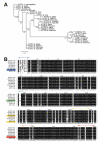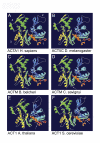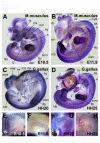Developmental expression of the alpha-skeletal actin gene
- PMID: 18518953
- PMCID: PMC2443135
- DOI: 10.1186/1471-2148-8-166
Developmental expression of the alpha-skeletal actin gene
Abstract
Background: Actin is a cytoskeletal protein which exerts a broad range of functions in almost all eukaryotic cells. In higher vertebrates, six primary actin isoforms can be distinguished: alpha-skeletal, alpha-cardiac, alpha-smooth muscle, gamma-smooth muscle, beta-cytoplasmic and gamma-cytoplasmic isoactin. Expression of these actin isoforms during vertebrate development is highly regulated in a temporal and tissue-specific manner, but the mechanisms and the specific differences are currently not well understood. All members of the actin multigene family are highly conserved, suggesting that there is a high selective pressure on these proteins.
Results: We present here a model for the evolution of the genomic organization of alpha-skeletal actin and by molecular modeling, illustrate the structural differences of actin proteins of different phyla. We further describe and compare alpha-skeletal actin expression in two developmental stages of five vertebrate species (mouse, chicken, snake, salamander and fish). Our findings confirm that alpha-skeletal actin is expressed in skeletal muscle and in the heart of all five species. In addition, we identify many novel non-muscular expression domains including several in the central nervous system.
Conclusion: Our results show that the high sequence homology of alpha-skeletal actins is reflected by similarities of their 3 dimensional protein structures, as well as by conserved gene expression patterns during vertebrate development. Nonetheless, we find here important differences in 3D structures, in gene architectures and identify novel expression domains for this structural and functional important gene.
Figures






References
MeSH terms
Substances
LinkOut - more resources
Full Text Sources

